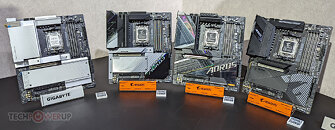Hands On with the new Gigabyte X670 Motherboards at Computex 2022
[ad_1]
Gigabyte will have a full lineup of boards coming later this year when AMD launches its AM5 platform, although based on the information we were given, the majority of its boards will be based on the B650 chipset. We should point out that there will be high-end B650 motherboards that will be priced similar to lower-end X670 models, which means that buying AM5 motherboards will be highly dependent on what features you favour. Unfortunately no B650 motherboards were on display and we won’t be sharing any details of these models at this time. As for the X670E versus X670 chipsets, as there are of course two per board, it seems like the difference comes down to PCIe 5.0 or PCIe 4.0 for the x16 PCIe slot as the major differentiator between Gigabyte’s different SKUs.
Starting from the bottom and working up, we have the X670 Aorus Pro AX, although there will also be an Elite model that should sit below the Pro in terms of features and pricing. The X670 Aorus Pro AX has a single PCIe 4.0 x16 for the graphic card, one PCIe 4.0 x4 slot and one PCIe 3.0 x2 slot, although the latter two use physical PCIe x16 slots. The board has a single PCIe 5.0 M.2 slot, as well as three PCIe 4.0 M.2 slots. Furthermore it has support for two USB-C 3.2 Gen 2×2 (20 Gbps) ports, one at the rear and one header for a case mounted port. There’s also a USB-C 3.2 Gen 2 (10 Gbps) port, but it’s unclear if this will support DisplayPort Alt Mode or not.
Other features include a 90A 16+2+2 power phase design, a 2.5 Gbps Ethernet port powered by an Intel chip, an Intel based WiFi 6E card, six SATA ports, a bunch of USB-A ports, a DisplayPort and HDMI out of unspecified flavours and a pair of 3.5 mm audio jacks alongside an optical S/PDIF out. We also spotted over half a dozen fan headers and the usual buttons for clearing the CMOS, power the board on etc. Overall this looks like a reasonably well featured board that sits in a bit of a strange place. The retail price should be just north of US$300.
Next up we have the X670E Aero D, which just as previous Aero boards is targeting creators, or at least people that are looking for fast external storage connectivity. Here we find a PCIe 5.0 x16 slot and this is also Gigabyte’s only X670E so far, with USB4 connectivity. An ASMedia ASM4242 USB4 host controller is used and the board ends up with a pair of rear mounted USB4 ports thanks to it that also supports DP Alt Mode and Thunderbolt 3. The board also has a PCIe 5.0 M.2 slot, as well as a further three PCIe 4.0 M.2 slots. This was also the only board that we could flip over and snap a picture of its fairly empty backside. However, we wanted to do this to show where the chipsets are located, which are on the bottom left side of the picture, surrounded by four screws.
Gigabyte has introduced another new feature, for Gigabyte at least, on this board, a push button that releases the graphics card latch, something ASUS had on some of its Z690 motherboards. The two x16 slots at the bottom of the board have the same configuration as the X670 Aorus Pro AX and the rest of the board is fairly similar in terms of the feature set. A nice addition here is a POST80 debug LED display and for some reason Gigabyte added a little leather tag to the heatsink over the PCIe 5.0 M.2 slot. Price wise, the X670E Aero D should end up somewhat below US$400.
The next entry is the X670E Aorus Master, which drops the USB4 chip in favour of a second PCIe 5.0 M.2 slot. Here Gigabyte has also upgraded the power design to a 105 A design, although the power phase count remains the same at 16+2+2. There’s also a nicely finned heatsink here over the power regulation components, but beyond that, there isn’t much that differs compared to the Aero D, although the rear USB-C ports are of the 20 Gbps and 10 Gbps variety, where the 10 Gbps port also supports DP Alt Mode. Pricing here is also a bit cheaper, with retail pricing ending up around the US$360 mark, which is close to what the X570S Aorus Master launched at.
Finally we have the X670E Aorus Xtreme, which is a very shiny motherboard if nothing else. Once again there are some fairly minor improvements here, with a 105 A 18-phase power design. The biggest difference between the Xtreme and the previous boards is support for up to four PCIe 5.0 M.2 slots, although this comes at the cost of the graphics card slot being limited to eight lanes of bandwidth, instead of 16. This is also the only X670-series board from Gigabyte with onboard 10 Gbps Ethernet that has been announced and it features the Marvell AQC113C, which is connected over PCIe 4.0. This is also the only board with actual buttons around the back for Q-Flash Plus and clearing the CMOS. Price wise, the X670E Aorus Xtreme will be cheaper than its X570 sibling at around $500.Note that some PCIe related features might be shared on some of these boards due to how AMD has designed the X670/E chipset and the PCIe 3.0 slot is also shared with two SATA ports. There’s a possibility that some of the hardware features will change before launch and the pricing isn’t set in stone either. We’re going to follow up with an article explaining a bit more about the X670 and B650 chipsets and some of the limitations of AMD’s new take on what a chipset is.
[ad_2]
















